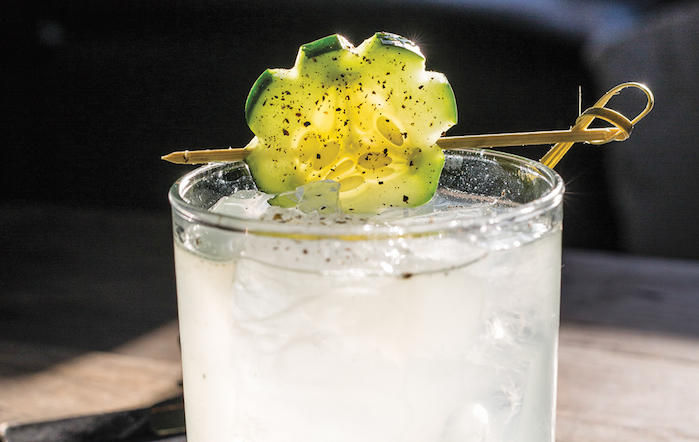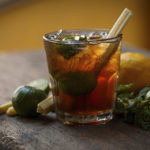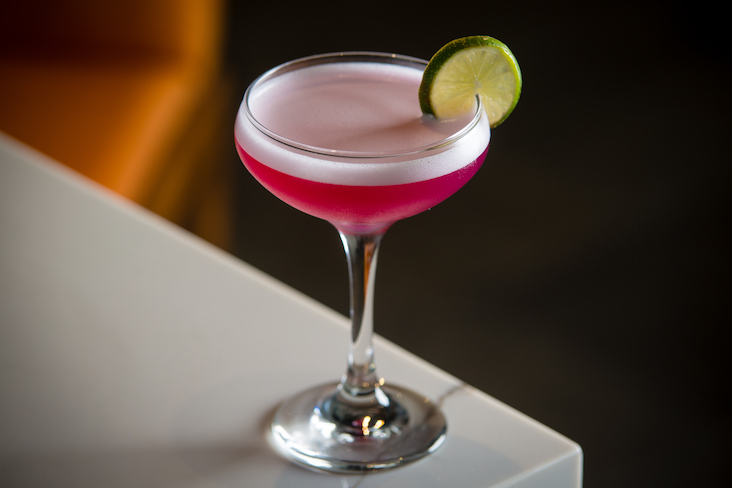Not since William Hogarth’s painting depicted the notorious Gin Lane in 18th-century London has there been a gin craze—at least in terms of the spectrum of styles and labels available.
Gin’s range of expressions has moved far beyond the original Dutch genever and London dry styles. Both established producers and craft distillers are exploring base spirit variations and botanical potpourris to introduce new and exciting gins to the market.
Inspired by this expanding palette of flavors, bartenders have been riffing variations on the many gin-based classics as well as creating a new wave of gin drinks. Not only is gin the workhorse staple at every bar, but classy “gin joints” are opening around the country, educating consumers about the multifaceted spirit.
Modern Expressions
“I have never seen so many unique and curious styles of gin,” says Keli Rivers, the “Ginnoisseur” or gin sommelier at Whitechapel Gin Bar, which opened last fall in San Francisco. At 500 different gins from around the world and growing, Whitechapel boasts the largest selection in North America. “When we opened more than seven months ago, London was our largest category; now we have a hard time finding bottle space for the contemporary styles,” says Rivers.
Among the bar’s curiosities are Oakland Spirit Co.’s Sea gin made with seaweed; Gracias a Dios gin made from 100% agave with 32 botanicals from each republic of Mexico; 15-year-old genever aged in Bordeaux barrels from the Rutte & Zn distillery, and Cambridge Distillery’s Anty gin, with a spirit base that includes foraged red wood ants.
It’s not just the specialists who are discovering and stocking unusual gins. Victoria Freehouse, a British-style pub in Philadelphia, now carries just 10 gins on the backbar, but that number is growing.
“Most of our cocktail list is gin based, and gin takes a prominent shelf behind the bar,” says Victoria Freehouse owner Edward Strojan. Among the stock is Philly’s own Bluecoat American gin, and the unusual Ophir Oriental Spice gin, made with botanicals found along the traditional spice route, including Indonesian Cubeb berries, Indian black pepper and Moroccan coriander.
Statistics bear out this proliferation of fancypants gins. All of the category growth is coming from the top shelf, according to the Distilled Spirits Council of the U.S., which pegged volume increases of superpremium gin at 37.8% last year. Of course, that segment’s 128,000 cases is just a drop in the bucket compared with nearly 10 million cases moved in the U.S. market; but that indicates there is more room for growth.

The Gin Room in St. Louis, MO, carries more than 300 expressions of gin on a backbar that climbs all the way to the ceiling.
Crafting Local
The economics of craft distilling is a factor in the propagation of new gins on the market. “Aging whiskey takes time, and craft distillers need product to sell while they are waiting. They can turn out gin in a week,” observes Peder Schweigert, general manager of the Marvel Bar in Minneapolis.
An unmarked speakeasy behind a purple door with avant-garde cocktails and eclectic décor, Marvel Bar stocks about 40 different gins. Among those are St. George Terroir, with botanicals of Douglas fir, Coastal sage and Californian bay laurel; and the local Far North gin.
“It’s a lot of work to sample and sort through all the new products on the market,” Schweigert notes. “Like the other craft industries, beer and wine, there are good ones and mediocre ones,”
At the Tough Luck Club in Tucson, AZ, “We are seeing educated drinkers who are interested in the more unusual variants,” says bartender Jon Holcombe. Part of a multi-faceted restaurant operation in a renovated funeral home, the bar is downstairs in what was the casket showroom.
The Tough Luck Club carries over a half dozen gins. The latest addition is ultra-local: Mount Lemmon gin, produced by Three Wells Distilling using botanicals from the slopes of the 9,157-ft. Mount Lemmon within Tucson city limits.
“For the longest time, the only gins available were a few of the big brands of London dry; now, there are all these new American-style gins on the market,” says Jim McCourt, beverage director at Prohibition restaurant and bar in Charleston, SC. Prohibition carries about 15 gins, including a few from local distilleries.
“People here are really into supporting community businesses,” McCourt says. “And visiting out-of-towners want to try the local booze.”
The local scene is so vibrant that a company is conducting tours of nearby distilleries. The operator arranged to end the tour at Prohibition for some discounted drinks to round out the experience. It’s been a plus for the restaurant. “We give them a good experience and get them to come back and enjoy our bar another time,” notes McCourt.
The Whiskey Connection
Although traditionally gin is a clear spirit, some producers have been releasing expressions that have been aged in barrels for a few months. This adds color and flavor, as well as polishes the edges. Those barrel-aged gins, say operators, are appealing to whiskey drinkers as well as gin aficionados looking for new experiences.
“Whiskey drinkers know that a lot of flavor comes from the barrel,” says McCourt, and they are interested in trying these gins.
The Marvel Bar just purchased a 30-gallon barrel of custom-aged gin from J. Carver Distillery in Waconia, MN. “It’s a real sipping gin that we can also incorporate into various cocktails,” says Schweigert. The barrel may be loaned to a brewer for custom-aging beer.
“Barrel-aged is one of my favorite categories. It’s a great way to convert whiskey drinkers to gin,” says Natasha Leila Bahrami, a.k.a. The Gin Girl. She carries nearly a dozen barrel-aged gins at The Gin Room in St. Louis, MO.
Bahrami discovered the category in her early 20s while sampling a Dirty Martini made with gin rather than vodka and became obsessed with learning about the juniper spirit, studying, tasting and bartending in various craft bars.
She opened The Gin Room three years ago in a section of her family’s 33-year-old restaurant Café Natasha. “People told me I couldn’t open a gin bar in St. Louis, because nobody drinks gin,” Bahrami recalls. “I did it anyway.”
Starting out with just 18 gins, Bahrami now has more than 300 expressions on a backbar that climbs all the way to the ceiling. The Gin Room also has an in-house aging program. At any one time, four to six commercial gins are resting in new or used barrels for anywhere from one to seven weeks. Prices for a 1-oz. pour range from $10 to $25.
Tonic Tune-Up
The Gin & Tonic is one of the most iconic cocktails, and several operators are offering new variations on that theme.
Since opening in July 2015, seasonal G&Ts have been a signature for Coquine, a full-service destination restaurant and neighborhood café in Portland, OR.
First was a Melon & Cucumber G&T, which started out with green-fleshed melons then switched to cantaloupe as the season progressed. The recipe added juices to the standard dry G&T, says co-owner/general manager Ksandek Podbielski.
“In the winter months, with less fresh produce available, we changed our approach by making our own tonic bases,” he says. The result was Pine and Sudachi Tonic, which is a classic combination in Japanese cooking, combining pine needles, cinchona bark, coriander, fennel seed, star anise and pepper with juice from the sour Japanese citrus.
In the spring, Podbielski infused simple syrup with local cherry tree blossoms, to sweeten a tonic base of equal parts cinchona and cherry barks. Portland is the Rose City, and those flowers inspired Podbielski to create Rose City ‘til I Die—with Hendrick’s gin, a rose petal and long pepper infusion, tonic and lime. The G&Ts are priced about $10 each.
In Philly, the signature at Victoria Freehouse is the Double G and T, which adds ginger, lime, thyme and mint to the tonic; it’s priced at $9.
The Gin Room offers a flight of three of its house-made tonics paired with gin for $21, “for people who don’t want to sample gin all by itself,” says Bahrami. The tonics rotate on a regular basis with four to eight on the menu at any given time. Added flavorings include lavender, hibiscus, lemongrass and apricot; featured G&T of the day are priced at just $7.









